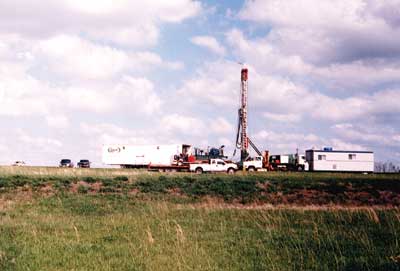| Kansas Geological Survey | Spring 2002 |
Vol. 8.2 |
|
Coalbed Methane
CONTENTS Coalbed Methane–page 1 Out-of-Print Publications–page 2
|
For
decades, coal has been the forgotten stepchild of Kansas energy production.
But today, a form of energy produced from coal, called coalbed methane,
has led to a boom in natural gas exploration in eastern Kansas. In parts of eastern Kansas, where oil and gas production is low and exploration all-but ended years ago, the search for coalbed methane has generated lots of activity. As many as 13 different layers of coal commonly lie less than 1,000 feet beneath the surface of this area, and companies can lease and drill for coalbed methane relatively quickly and inexpensively. One company alone, Devon Energy Corporation, headquartered in Oklahoma City, has leased more than 420,000 acres in northern Oklahoma and southeastern Kansas (Wilson and Neosho counties) for coalbed methane exploration. Devon has drilled 125 wells in the area in the past year and plans to drill another 200. Devon's Kansas wells are expected to produce 25 million cubic feet of natural gas a day in 2002, and 52 million cubic feet a day in 2003. "An average coalbed methane well in Kansas can produce 60 million cubic feet of natural gas over a two-year period," said Survey geologist Larry Brady, who has studied Kansas coals for more than 30 years. "At today's prices, that gas has a value of more than $200,000. Some southeast Kansas wells have produced now for more than 10 years. If enough of these wells come online, the potential is great." Coalbed methane is produced in much larger amounts in other parts of
the country, such as the San Juan Basin in Colorado. But Brady says that
Kansas coal beds offer some strong possibilities. Coal underlies much of the eastern fourth of Kansas. Most of it was
deposited during the Pennsylvanian Period, or Coal Age, about 300 million
years ago. Those coal layers have long been mined in the state, with annual
production peaking at about 7.25 million tons around World War I, and
trailing off ever since due to the advent of other energy sources and
the high sulfur content and thinness of Kansas coals as compared to those
from the western U.S. In 2001, Kansas coal production totaled 190,000
tons. "Most of our coal beds are less than two feet thick," says Brady. "To be successful, a coalbed-methane well may need to produce gas from several of these thinner beds." The search for coalbed methane has led to numerous inquiries for information about the gas and the leasing of land for mineral rights. In response, the Survey published Public Information Circular 19, describing coalbed methane production and leasing. Copies of the circular are available from the Survey at no cost. It is also available electronically (http://www.kgs.ku.edu/Publications/pic19/pic19_1.html). Exploration efforts have also led to a jump in the demand for coal-related information and logs of oil and gas wells drilled in eastern Kansas. "We're getting lots of phone calls and visitors to talk about coalbed methane," said Brady. “Companies are looking at eastern Kansas data that haven’t been looked at in years. "In its own way, coal is making a comeback." |
|
Geologic sampling for coalbed methane in northern
Miami County. |
 |
| Online February 10, 2003 Comments to: lbrosius@kgs.ku.edu Kansas Geological Survey URL:http://www.kgs.ku.edu/Publications/GeoRecord/2002/vol8.2/Page1.html |